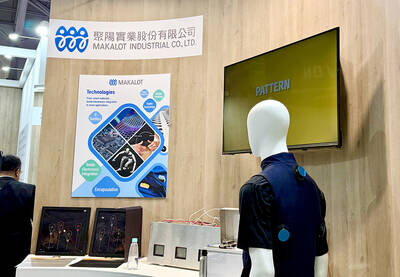More than 500 million kilowatt-hours (kWh) are likely to be sold through a Taiwan Renewable Energy Certification Center program through the end of this year, driven by intense corporate demand for green energy, the Bureau of Standards, Metrology and Inspections (BSMI) said yesterday.
The Ministry of Economic Affairs’ bureau administers the Taiwan Renewable Energy Certificate (T-REC) program.
Each certificate represents 1,000kWh of electricity from renewable sources.
The first deals were announced in May, with Taiwan Semiconductor Manufacturing Co (TSMC, 台積電) being the biggest buyer, the bureau said in a news release.
Speaking to the Taipei Times by telephone, BSMI division director Huang Chih-wen (黃志文) said that pent-up corporate demand for green energy explains the program’s quick adoption.
“A lot of the deals were in the works long before we opened the T-REC platform,” Huang said. “As soon as they saw that the first batch of transactions went smoothly, everybody jumped in.”
While the first batch involved mostly solar power, most of the upcoming deals will be from onshore wind projects, Huang said.
“We anticipate reaching 500 million kilowatt hours by the end of the year,” Huang said, adding that the exact schedule is uncertain because parties take their time before signing deals, which run for up to 20 years.
TSMC in May bought 38,259 certificates of the 38,318 available, the center’s Web site showed.
TSMC in July signed the Climate Group’s global RE100 pledge, promising to be “committed to 100 percent renewable electricity” by 2050.
Also in July, the firm inked the world’s largest corporate power purchase agreement with Danish energy giant Orsted A/S, buying all of the energy generated from Orsted’s 920 megawatt wind farm off Changhua County for its 20 year lifespan.
The bureau’s role includes working with Taiwan Power Co (Taipower, 台電) to track green electricity generators connected to the Taipower grid and electricity from the grid that goes to a green energy buyer.
Taipower charges NT$0.058 per kilowatt hour to “wheel” energy from renewable sources through its grid from supplier to producer.
An amendment last year to the Renewable Energy Development Act (再生能源發展條例) provided the legislative structure for T-REC, Huang said.
“The independent power producers are protected,” Huang said. “They can leave Taipower to sell their electricity to corporate offtakers at a higher price, but they have the option to return to Taipower at any time at the same rate that they were getting before they left.”

Nvidia Corp chief executive officer Jensen Huang (黃仁勳) on Monday introduced the company’s latest supercomputer platform, featuring six new chips made by Taiwan Semiconductor Manufacturing Co (TSMC, 台積電), saying that it is now “in full production.” “If Vera Rubin is going to be in time for this year, it must be in production by now, and so, today I can tell you that Vera Rubin is in full production,” Huang said during his keynote speech at CES in Las Vegas. The rollout of six concurrent chips for Vera Rubin — the company’s next-generation artificial intelligence (AI) computing platform — marks a strategic

REVENUE PERFORMANCE: Cloud and network products, and electronic components saw strong increases, while smart consumer electronics and computing products fell Hon Hai Precision Industry Co (鴻海精密) yesterday posted 26.51 percent quarterly growth in revenue for last quarter to NT$2.6 trillion (US$82.44 billion), the strongest on record for the period and above expectations, but the company forecast a slight revenue dip this quarter due to seasonal factors. On an annual basis, revenue last quarter grew 22.07 percent, the company said. Analysts on average estimated about NT$2.4 trillion increase. Hon Hai, which assembles servers for Nvidia Corp and iPhones for Apple Inc, is expanding its capacity in the US, adding artificial intelligence (AI) server production in Wisconsin and Texas, where it operates established campuses. This

US President Donald Trump on Friday blocked US photonics firm HieFo Corp’s US$3 million acquisition of assets in New Jersey-based aerospace and defense specialist Emcore Corp, citing national security and China-related concerns. In an order released by the White House, Trump said HieFo was “controlled by a citizen of the People’s Republic of China” and that its 2024 acquisition of Emcore’s businesses led the US president to believe that it might “take action that threatens to impair the national security of the United States.” The order did not name the person or detail Trump’s concerns. “The Transaction is hereby prohibited,”

Garment maker Makalot Industrial Co (聚陽) yesterday reported lower-than-expected fourth-quarter revenue of NT$7.93 billion (US$251.44 million), down 9.48 percent from NT$8.76 billion a year earlier. On a quarterly basis, revenue fell 10.83 percent from NT$8.89 billion, company data showed. The figure was also lower than market expectations of NT$8.05 billion, according to data compiled by Yuanta Securities Investment and Consulting Co (元大投顧), which had projected NT$8.22 billion. Makalot’s revenue this quarter would likely increase by a mid-teens percentage as the industry is entering its high season, Yuanta said. Overall, Makalot’s revenue last year totaled NT$34.43 billion, down 3.08 percent from its record NT$35.52